One of the Joys of Maturity |
|
| Affiliated Advertisers |
Clicking through one of our banner ads or some of our text links and making a purchase will produce a small commission for us from the sale. The Old Guy's Garden Record
Possibly the most noticeable thing about our main garden last week was the erection of our pea trellises. Since I really hate bending over a lot to pick peas, I grow mostly taller varieties on nylon trellis netting
While working up and raking the main bed, I noticed that our asparagus really needed to be picked. I'd done a heavy picking yesterday after we'd been out of town for a couple of days. I thought I could skip a day before picking again, but the tasty spears are coming on strong, our reward for several years of nurturing the bed. Our planting of asparagus looks pretty spotty above, as some of the roots haven't yet begun to emerge (down the center of the bed). I've also let some very small seedlings begin to grow that are too small for picking, but will fill in some bare spots at the ends of the bed nicely. When I saw that it had rained overnight, I really thought I'd just take it easy today. But with the tilling of our main bed and a few test rows turned over in our East Garden, I should sleep well tonight! Monday, April 2, 2012 - Transplanting Brassicas
I use an old, but effective soil pH meter In the United States, areas east of the Mississippi generally have somewhat acid soil. Areas west of the Mississippi usually have an alkaline soil pH. Some old hands can fairly accurately tell a soil's pH just by the plants growing on the ground (for example: clover grows well on "sweet," neutral soil). For the rest of us, testing several places in our garden is the only way to be sure.
Of more importance, I watered each hole with a dilute solution of starter fertilizer
The brassicas will eventually get mulched with grass clippings to control weeds and hold in moisture. I mowed and raked a bit today, but our garlic seemed to need the mulch more than the brassicas, so they'll have to wait. I also still need to spray the brassicas with Thuricide One thing I did remember to do was to spread a bit of dog, rabbit, and deer repellent around the brassicas. I used the more expensive Shot-Gun Animal Repellent
What I did transplant was:
As soon as I finished my transplanting today, I unpacked and potted the corms in six inch round pots. For gloxinias, I mix peat moss with regular potting soil in about a 1:4 ratio to lighten up the mix. I also add a bit of ground limestone to neutralize the natural acidity of the peat, along with a bit of bone meal, if I have it on hand, to promote root and corm growth.
I haven't added Nature Hills to our listing of seed and plant suppliers in our Gloxinias feature story as yet. I'm waiting to see how these corms do. At a bit over $10.50 each (with shipping), all four need to produce viable plants for me to be a happy customer. Their "guarantee," beyond covering damage in shipment, isn't all that great. If one of the corms doesn't make it, they'll replace it in the first year for half price plus shipping. I guess such a policy is necessary for them to stay in business, but with something like a gloxinia corm that will take some time to show growth (or death), it's not all that good a guarantee. It rained last night. Actually, it poured...so hard that it woke me up during the night. And while tilling won't be possible for a while, we really needed the rain. Sadly, it would appear that the showers were a bit spotty, as the Weatherunderground reporting station about six miles south of us got only a half inch of rain, while we got a couple of inches! Along with the rain, it appears that we're going to be getting a stretch of more normal April temperatures for a while. That will make working outside a lot more pleasant, but I'm also keeping an eye on forecasted overnight low temperatures in the mid to upper 30s for the next few nights. Our frost free date in this area is around May 1, so a hard frost is still a possibility.
The cooler temperatures also seem to agree with the variety of hanging basket plants we have all around our back porch. Other than a geranium and some petunias in a planter on our cistern, the hanging basket plants are the only tender plants we have outside unprotected. And of course, if those predicted mid-30s should turn into a frost, we can always bring the hanging baskets inside overnight.
Our downstairs plant rack remains crowded with lots of transplants, along with our gloxinia collection. The first tray of melons went onto our heat mat with a rather high setting (85o F) that is necessary to germinate seedless watermelon. One seed vendor recommends a 90o temperature for starting seedless watermelon, but I burnt out a heat mat when I tried going that high a few years ago. If 85o won't do it, we'll just have to spit out seeds this summer when we enjoy our watermelon. Since I planted heavy (4-5 seeds per pot) and can move multiples, I started just one pot of each variety (for now...we'll do more later). Cantaloupe/Muskmelon
Watermelon
Honeydew
Squash
Wow! Looking at all the stuff above, I think I went a little nuts starting seed yesterday. And the listing doesn't even include the fourpack of marigolds I seeded! I'll also be starting some butternut squash and pumpkin transplants a bit later. I have to keep our butternut planting separate from the melons, as the butternut vines will take over an area, crowding out the less vigorous melons. I like to wait on starting pumpkins, or we could be carving jack-o'-lanterns in August! Full disclosure: Not one of the variety links above is to any of our affiliated advertisers! I included links to vendor product pages so readers can easily find the varieties if they're interested. But I certainly do appreciate all of the readers who have clicked through one of our affiliate advertiser links and purchased something. The commissions are small, but they do add up and help. A pleasant surprise this morning under our plant lights got me busy updating our Gloxinias feature story. I'd taken three leaf cuttings from a gloxinia last November at the same time I was getting cuttings from our ivy leaf geraniums. While the geraniums rooted quickly, the gloxinias took a good bit more time. The first produced a baby gloxinia in February. This morning, I saw that the last two browned and shriveled gloxinia leaf cuttings each had a baby gloxinia at its base.
I didn't get much gardening done over the weekend, as one of our daughters and her boyfriend had driven down from Chicago to camp at Turkey Run State Park for a couple of days. We had a great visit and enjoyed hiking the Rocky Hollow trail at the park. I hadn't been to Turkey Run in years, but its just as beautiful as I remembered it being from past trips there. If you're passing through Indiana this summer on I-70 or I-74, Turkey Run is about an hour's drive off the interstate on U.S. 41 (north from Terre Haute on US 41, or south from I-74, again on 41) and a great place for camping, hiking, canoeing, and family gatherings.
You'd think after taking a couple of days off from gardening, I'd be hot at it today. But our weather forecast calls for a pretty good chance of a frost, if not an outright freeze, on Tuesday night. So I held off on transplanting onions or lettuce today, although both would probably survive a light frost. I had plenty of other chores that needed doing.
The small compost pile in the foreground at right is our "mature" pile that I still need to finish screening and using. The limed ring is where our working pile stood, and in the background, our long-term pile of heavy stems and leaves, the freshly moved pile, and our ugly burn pile. But as you can see, it was a pretty setting in which to work. We've actually treated this field pretty much like a bad lover, taking and never giving. I have a couple bags of lime and a couple more of fertilizer to spread on the field soon, as you simply can't take hay (clippings) over and over and expect the ground to still produce. I may even spill a little grass seed on it. Let me add something here that has worked for me on a number of occasions. I often use the site where a compost pile has been to direct seed or transplant a large hill of butternut squash, pumpkins, or a similar crop. The limed ring in the photo above was the site of a previous compost pile. When I used up that pile last spring, I transplanted butternut squash to the site. Lots of nutrients leach out of the compost pile into the ground below it, making such a site ideal for later planting. Since I had a vining crop on the spot last summer, I'll probably need to rotate that spot out of production this year (sigh, hate to waste fertile ground). That's last year's butternuts (above) growing on what was and then became again the site of our compost pile with the rest of our East Garden in the background. Our East Garden changes in configuration each year as we adapt the area to our growing and rotational needs. Tuesday, April 10, 2012 - A Freeze Coming
And really, it is just April 10. Even though we've had weeks and weeks of non-freezing weather, our frost free date for this area is May 1 or so. But it still doesn't make getting ready for the frost any easier. Fortunately, I'd held off putting out any tender plants, other than a few flowers I stuck in a planter on our cistern. They're now covered with a scrap of floating row cover left over from last fall's lettuce crop. Our tender transplants are all under the cold frame. I closed the cold frame a bit early this evening while the sun was still on it. I wanted to allow a little extra heat to build up in it. Even though they're fairly hardy, our lettuce and beet transplants went under the frame, as we had space available. Our leftover brassicas and our onion transplants will get to tough out the cold on the back porch. And all of our hanging basket planters are lining the walls of our kitchen tonight (and probably tomorrow night, too).
In terms of real gardening, I turned about a third of what will be our East Garden this morning. I began with the toughest section first, areas that hadn't been turned over for a year or two. The tiller didn't penetrate far into the soil, but ground up the vegetation on top pretty well. The section I turned will have to be tilled at least twice more before it's planting ready. Most of the rest of the East Garden was in production last year, so the soil should turn over pretty well and fairly deep. "Should"...
With the way I'm going about it this year, I'm going to have to turn all of the sections in the East Garden area that we've used since we started gardening this area in 2009. But at least a quarter of the tilled ground will go back into a cover crop to improve the soil a bit for next year. Part of what I turned today had patches of alfalfa I had planted last year as a cover crop. The alfalfa really didn't take well in last summer's heat, but enough survived that it may have done some good penetrating the plow pan that exists in part of the East Garden. Before I could till, I had to get the last of our mature compost screened and moved. It went into the bed where our onions, carrots, and beets will be. And of course, it was a touch chilly out this morning, but it turned out to be another gorgeous day to be working outside. The weather folks were right, and it got down to a little below 30o last night. We didn't experience any frost or freeze damage, as our tender transplants were all under our cold frame and our hanging baskets spent the night in the kitchen. Equally important, I got outside early enough this morning to open the cold frame before the full sun was on it. I missed doing that one morning last year and ended up cooking some of our transplants. The hanging baskets all went back out to the porch, only to come back inside late this afternoon, as we have another frost advisory for tonight. Once the sun got out today, it was a glorious day for working in the garden. I decided to get the rest of our East Garden tilled, but ended up just tilling the whole thing. A few areas that now have been turned twice could be planting ready, especially the row where I dug our sweet potatoes last fall. But most of it will take a couple more rounds with the rototiller before I can direct seed to it. I may get by with just one more pass in the melon areas, as I mostly transplant melons and can hold down weeds with later tilling and mulching. I didn't get out a tape measure, but the area currently tilled paced off at about 75' square. As I mentioned yesterday, we won't use all of that area, but will plant 1/2 - 3/4 of it, putting the rest into some kind of cover crop.
Along with the long stretch of unseasonably warm weather we've had, it's also been much dryer than usual. I'd guess that our local water table can use all the precipitation it can get. But the main garden really looks great after, well, in between, rains. There's lots of thunder outside as I write as the next storm cell approaches. Ohio gardener Mike Bryce sent me some great shots of one of his garden plots from last summer and of what he currently has going in his greenhouse. In the absence of me doing anything worthwhile other than watching it get really, really dark outside, I'm going to share his images for you to enjoy.
I'm probably never going to have a greenhouse, but that doesn't mean I can't enjoy the beauty of others' greenhouses.
In one of those "Duh" (accompanied by a palm smack to the forehead) moments, I realized that I probably had a suitable pig picture somewhere in my image files from our farm days. And while overlaying the text onto the photo took a lot longer than it really should have, I had my graphic in fairly short order. I'll leave to you which party one might apply the graphic's message (both?), as I try to keep this site non-political. BTW: The sow's name was Leslie. She was a very good mama...most of the time. More Rain
It remained cloudy and very windy today. With the ground quite wet, I confined my outdoor gardening to picking asparagus. In between showers yesterday, I did get our paper cup cutworm collars off of our brassicas. I use scissors to cut down the sides of the bottomless cups, removing half at a time to keep from disturbing the roots of the plants too much. Then I pull loose soil around the stems and pack it down to fill the holes left by the cups and ensure good root contact with the surrounding soil.
Last year, I had to repeatedly reseed our late peas to get an acceptable stand. So while things look a bit uneven, I think we're doing much better than last year with our peas. Looking at our main garden plots from the end of our property and our asparagus bed, things look pretty good for this time of year. Tuesday, April 17, 2012 - Planting at Last I transplanted and seeded a bed to onions, beets, and carrots today. I used our newest raised bed for the planting. Its interior 3' x 15' dimensions made me change my usual planting practice. I like to plant double rows of onions, carrots, onions, beets, and more onions in our softbeds. The three foot width made me omit the usual middle double row of onions, but I won't have to step into the bed until harvest time. All cultivating and weeding can be done from the edges.
I just use a wide trowel to pull open a hole for the onion plants. When separating the onion plants in the flat they were grown in, I often lose most of the soil off the roots. Fortunately, onions seem to tolerate being bare rooted into the ground. Using the trowel to pull soil over the roots also makes the hole for the next pair of onion plants. I leave 3-4" between onion plants in the row. In the past, I've left less, thinking I'd be back and use every other plant fresh before the onions completely bulbed out. That never seemed to work, and we had onions pressing against each other at harvest, which can lead to spoilage. So I was really careful about spacing today.
After repairing the puppy damage, I moved my now, much shorter twine to the next planting stakes as a guide for making my carrot rows. I made shallow dibbles by sliding a planting board down the row, carving out about a half to three quarters of an inch of soil. If using fresh seed, one can save themselves a lot of thinning later by carefully spacing carrot seeds about an inch apart. Of course, carrot seed is tiny and hard to handle. As most of our seed was a year or two old, I used that as an excuse to just seed the carrots heavy (and growl later when I have to thin). I also sprinkled some radish seed in the row. (You can just barely make out the radish seed in the larger view of the image at right.) The radish germinate quickly, and in theory, break the soil surface for the slower germinating carrots. Also in theory, the radish should be ready to be picked before they interfere with the carrots. See The Radish Murders and Grass Clipping Mulch for more information about using radishes as a nurse crop for carrots. After firming the soil over the carrots, I moved on to transplanting a double row of beets and another double row of onions, plus geraniums at the four corners, to finish out planting the bed. Since I had a cartful of rainwater from recent storms, I just added some starter fertilizer to it and used my watering can to water in the fresh seeding and transplants. One final step in my planting today, brought to mind by the earlier puppy damage, was to spread some animal repellent on the bed to keep said puppy and other passersby away. Saturday, April 21, 2012 - Still on Hold Our outdoor gardening continues to remain on hold, due first to wet, and now, cold weather conditions. Although various weather reporting services have differing predictions, the one for an overnight low temperature of 32o for Sunday/Monday definitely caught my attention.
Walking/Planting Boards for Carrots
Once the radishes I overseeded the carrots with begin to germinate, I'll need to pull the walking boards. By that time, they will have given the carrot seed about a week's head start on any possible weed germination.
I was also pleased this morning to see that our beet transplants, often an iffy transplant, appear to be recovering from their transplanting shock and taking hold. I was prepared to go back and direct seed any bare patches in the row, but most of the beets seem to be benefitting from the rain and cooler temperatures. The smaller beet transplants appear to be doing much better than the larger ones. And yes, there are geraniums at the corners of the raised bed shown at right that will have to be covered this weekend to survive the predicted frost/freeze. I have a few HotKaps Peas in Bloom
The variety blooming are Amish Snap peas from the Seed Savers Exchange. Our Champion of England, also from SSE, and Mr. Big from Shumway, both failed to germinate. I replanted that area with some Mr. Big Our next peas to come into bloom should be our old fashioned Sugar Snaps. We take Sugar Snaps in the pod for table use and freezing, but also shell them at times when we have other shell peas to freeze. Our Eclipse and Encore peas planted on March 26 are just a few inches tall, so we should have an extended pea harvest. Whew! As I finished up this posting, I saw that the weather service that had predicted an overnight low of 32o for Sunday night had revised their prediction to 36o. Maybe somebody goofed, and it was just a misprint, but it had me worried. Good Web Hosting I noticed this morning that our web host, Hostmonster, is again offering a really good deal for new customers on web hosting this month. Every now and then, they run an offer for hosting at $3.95 per month (considerably less than we paid for our latest renewal!). The offer ends April 30. The predicted frost for this morning didn't do any damage in our gardens. Of course, I had almost all of our hanging basket plants inside overnight, the cold frame shut over our tender transplants, HotKaps over some geraniums I'd transplanted last week, a scrap of floating row cover over our planter on the cistern (and its petunias and geranium), and even brought our tray of lettuce transplants inside to the kitchen table for the night.
After making the rounds, carrying planters outside and removing frost protection, I checked the weather reporting station a few miles south of us. They recorded a morning low of 34o, low enough to make me glad I'd taken the time to protect our plants. Then I noticed on CNN that areas from Pennsylvania up through New England were getting snow, a good bit of it in places like Newfield, New York (10") and Ridgebury, Pennsylvania (8")! I started out to transplant lettuce this morning, but when I looked at the area to be planted in our main raised bed, I realized that I had another chore to do first. The soil level in the main raised bed just wasn't where I wanted it. So I made a trip to Terre Haute for a truckload of topsoil mixed with composted horse manure to raise the soil level up to where I wanted it. By the time I got the soil unloaded, spread, and tilled in, I really didn't want to transplant anything anymore. And I'd like the section to catch a good rain before I begin transplanting into it. The easy chair awaits!
It's still a great calendar, and Habitat does good works. But I wish instead of sending freebies they'd just put my small contributions into helping folks. Planting Lettuce, At Last I ended up not waiting for our freshly tilled main raised bed to get rained on before transplanting lettuce into it. After waiting on freezing weather to pass and then realizing that I needed to add soil to our raised bed before planting or transplanting, I was really getting antsy to get going on gardening. What made the difference was a great day for working outside with the chance of rain later in the day.
I like to grow our lettuce on the ends of our main raised garden bed or in the newer, narrow raised bed so that I can reach in and weed, mulch, pick, and replant lettuce without ever stepping into the bed. Our crop rotations this year prevented planting in the usual spots, so I marked a 42" wide area towards the center of our main raised bed for the lettuce. Since I noticed radishes peeking out from the edges of the planting/walking boards I'd laid over our carrot rows, it was time to pull those boards...and they, of course, worked out nicely for keeping my weight spread out in the aisles between beds and my feet out of the bed. I began transplanting with a row of four lovely Skyphos transplants down the middle of the section. Then I worked my way out from the center row with a variety of other head, softhead, leaf, and romaine lettuces. We'll harvest the lettuce as it becomes ripe, but won't be replanting a succession, as we have no luck growing lettuce in hot summer weather. But we'll also raise another, often better, fall crop of lettuce after the summer heat is past. We had fresh lettuce well into November last year.
I used up the last of our onion transplants for double rows outside the lettuce, and even got in a row of spinach at the far end of the bed. I was tempted to go ahead and begin transplanting peppers and tomatoes today, but our transplants haven't really had enough time outside as yet to harden off properly. I love planting lots of varieties of lettuce. Once they get a bit of size on them, the colors are incredible. And since lettuce seed is relatively inexpensive and keeps well in the freezer from year to year, I just buy a packet or two each year, but have lots of packets to choose from at seed starting time. And I ended up getting lucky, as we caught a very light shower in the early afternoon, with a much heavier shower around suppertime. That should get all the transplants off to a good start. We're into what appears to be our spring rainy season with a good chance for rain almost every day for the next ten days. While that puts a crimp in any plans to till our East Garden, our lawn and our main garden really need the rain. I did get out and transplant a row of peppers into our main raised bed this week. I just put in six plants, as we've had far more peppers than we could use, freeze, or even give away the last couple of years. I transplanted two Ace F1 (red), two Mecate (yellow), one Red Knight, and one Earliest Red Sweet. While I didn't give our lettuce transplanted earlier in the week any cutworm protection, I did use paper cup cutworm collars for the peppers. Cutworms seem to find young pepper plants particularly tasty.
Even though we're probably past any danger of frost, the melons went under the cold frame propped part way open for a couple of days before I fully opened it up today. The shock of full sun can really fry melon starts, something I've done in the past and don't wish to repeat. While our garden and transplants are mostly going well, I had one nasty surprise this week. One fourpack of tomato seedlings began showing the telltale spots of bacterial spot disease. I had hot water treated all but one variety of our tomato seed, but apparently either the untreated variety (from a trusted source) or my treated seed still carried the disease. The infected plants, obviously, were all thrown out. And I do mean thrown out...into the trash can instead of into the compost pile. I had sprayed the tomatoes and peppers with Serenade as a precaution when I brought them outside, so I hope that we're past any disease problems in the remaining seedlings.
Last April, we had over eleven inches of rainfall. It's been much dryer this month and spring, but I think mother nature has been trying to catch up all at once today. We had gulleywashers both last night and this evening, pushing our monthly rainfall close to five inches for the month. Once again, recording stations east and south of us received considerably less precipitation, as the heavy rainfall was pretty spotty. In between all the rain, I got out and transplanted tomato plants this morning and mowed a bit in the afternoon, finishing just as the rain began. With the dimensions of our raised beds and of our tomato cages, I can put six caged tomato plants in an east-west row in our main garden. I cut that back to just five plants this year, as I hope the extra space may make for healthier plants. With just Annie and I still at home, four main season tomato plants plus one grape tomato plant will supply all the slicing tomatoes we can use. I will, of course, be transplanting a good many more tomatoes for canning (and saved seed) in our East Garden, once it dries out enough to till again. I put in one Red Candy, and two each of Better Boy and Moira. I usually include a Bella Rosa plant or two in the main garden, but I pitched our Bela Rosa transplants, as they and one other variety showed signs of bacterial spot disease. Our caged tomatoes are at the north end of our main raised bed this year, as I was looking for ground that hadn't had tomatoes on it for several years. When I transplant our tomatoes, I dig a deep hole for each, working in a bit of calcitic lime for the calcium tomatoes require and a little 11-23-11 fertilizer. I'm not worried about the lime making the soil too sweet for tomatoes, as I'd added a good bit of peat moss to the row a week or so ago.
I dig a small trench around each transplanted tomato for our tomato cages. Because our tomato plants tend to get a bit top heavy with the cages we use, I need to anchor them firmly so the strong winds we frequently experience won't topple the plants over. If that happens, it creates a mess, and often partially uproots the tomato plant, pretty well spoiling the harvest from it for the season. Note that I go ahead and add our tomato cages now because the soil is loose and easy to work. One could easily put off adding the cages until the plants were a bit bigger. To finish off the planting, I added geraniums at the corners of the bed and some marigolds, impatiens, and vinca along the edge of it. The tomatoes are purposely on the north end of the bed for crop rotation, but also so they won't shade out plants to the north of them. So, we'll see how the flowers do. I obviously included sun and shade loving plants in the mix.
Our squash, melons, and sweet corn all will go in our East Garden. I've turned the whole area once this spring, but now have to wait for it to dry out before tilling at least once more before beginning planting. I also have a bunch of herbs to transplant into a new herb garden I plan to build around our shallow well. I pulled together the images that usually appear at the top of this blog for an animated gif image of our main garden in April. From Steve, the
at Senior Gardening |
| Affiliated Advertisers |
©2012 Senior-Gardening.com








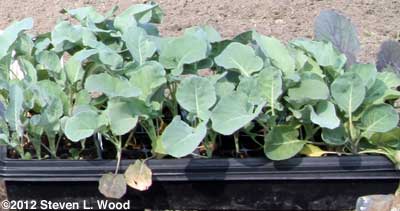







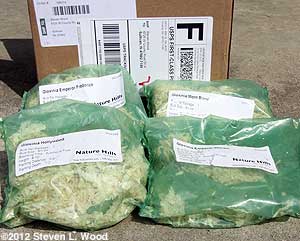


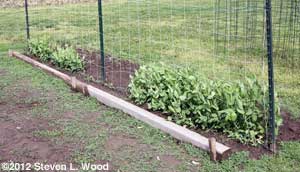



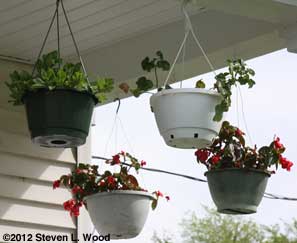




















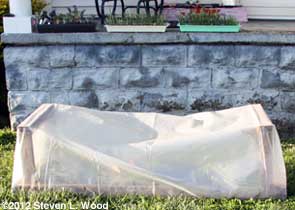
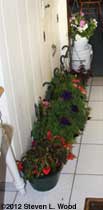


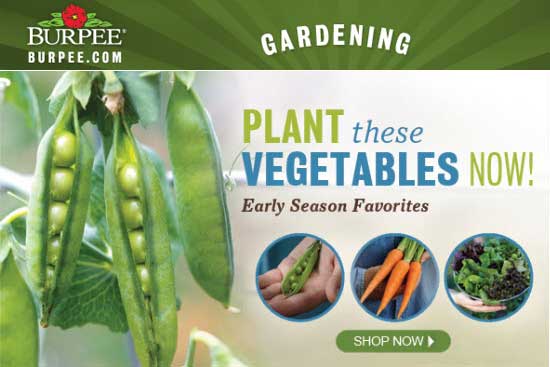
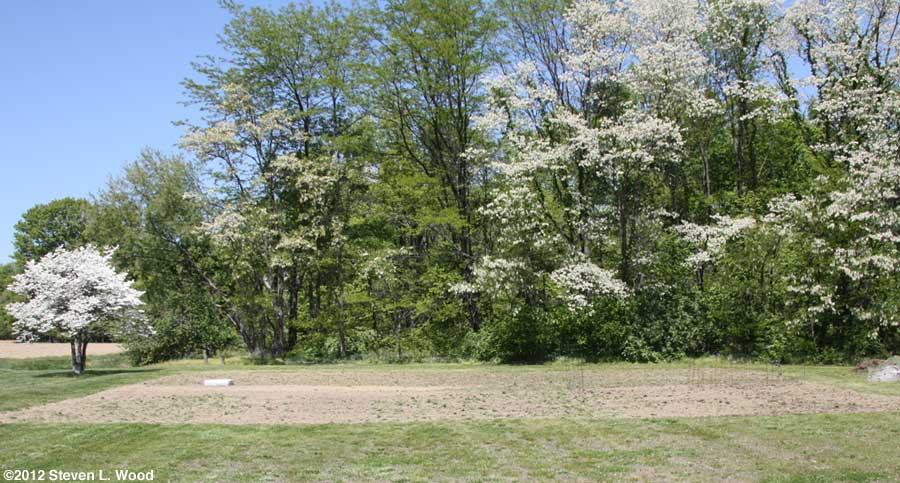
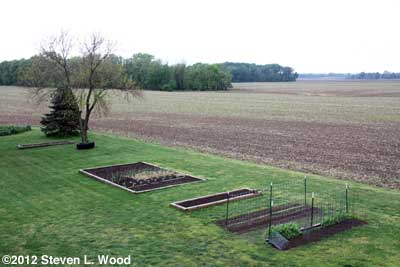























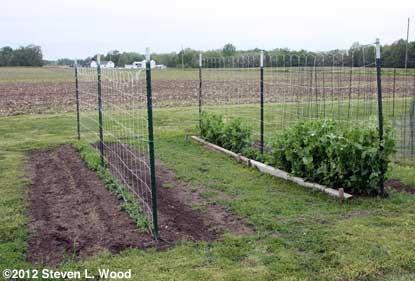













 With the tomatoes in, we have our main garden beds completely planted for now, other than some flowers around the edges that I'll add when I have time. This is probably the earliest we've ever gotten these beds completely planted. Missing from the plantings are any kale or green beans, as they'll go in as succession plantings when the spring lettuce and our garlic come out of the middle of the bed. Our cucumbers will also be a succession planting, going on one of the trellises that is currently filled with pea vines. The other trellis will be used for an heirloom pole bean variety a reader generously shared with us.
With the tomatoes in, we have our main garden beds completely planted for now, other than some flowers around the edges that I'll add when I have time. This is probably the earliest we've ever gotten these beds completely planted. Missing from the plantings are any kale or green beans, as they'll go in as succession plantings when the spring lettuce and our garlic come out of the middle of the bed. Our cucumbers will also be a succession planting, going on one of the trellises that is currently filled with pea vines. The other trellis will be used for an heirloom pole bean variety a reader generously shared with us.